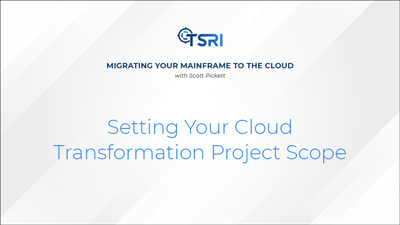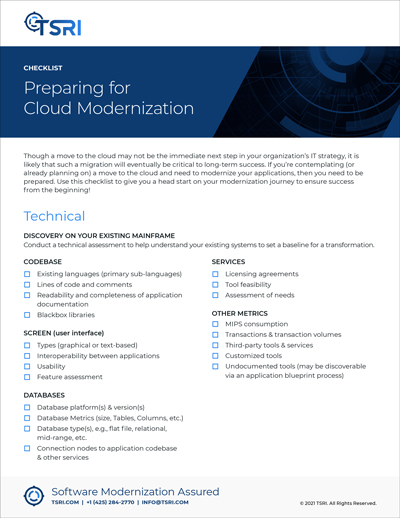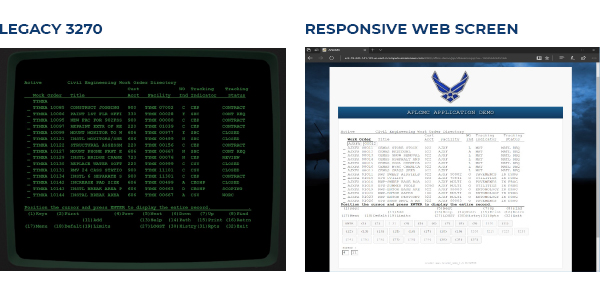As we enter a new year, it’s only natural to look back on what we accomplished in the past 365 days. Many of those accomplishments centered around explaining what TSRI does in a way that nearly everyone can understand. Software modernization and refactoring solutions are, by their very nature, complex concepts. Teams of specialized engineers are required to successfully complete each project, and even the simplest automated transformations can take months to get all the right pieces put into place.
In this blog, we highlight some of the most informative pieces published in 2021. These materials were designed to help make the automated modernization process easier to understand and navigate from start to finish. We hope you’ll find them useful as you consider your organization’s IT plans and modernization initiatives for the coming year.
GETTING READY TO MODERNIZE!
 Modernizing to the Cloud
Modernizing to the Cloud
Scott Pickett, TSRI’s Vice President of Product Operations and Service Delivery, conducted a live presentation that discussed how automated modernization can help organizations move their applications to the cloud. The presentation resulted in a complete series of videos, all of which are accessible from the post linked above.
 Check out this article featuring a downloadable Checklist: Preparing for Cloud Modernization to help you assess your organization’s current assets, including your existing codebase, databases, and other tools that may be installed on your mainframes and other legacy technologies.
Check out this article featuring a downloadable Checklist: Preparing for Cloud Modernization to help you assess your organization’s current assets, including your existing codebase, databases, and other tools that may be installed on your mainframes and other legacy technologies.
MODERNIZE WITH LESS DISRUPTION
One of the major risks of any modernization is the amount of time a system will be taken offline during cutover to the new environment. Any downtime becomes a disruption to the business, whether that means lost revenue or maintaining security of mission-critical systems. This post, 4 Tips for Modernizing with Minimal Business Disruption discusses ways that organizations can mitigate disruption, and also explains how proofs of concepts, step-wise automated migrations, and proper planning play into maintaining continuous uptime.
 Common Misconceptions About Modernization (And What to Do About Them)
Common Misconceptions About Modernization (And What to Do About Them)
Application modernization is a game changer in any organization. Oftentimes, perceived obstacles, such as prolonged system downtime, get in the way of bringing mission-critical applications to modern programming environments. This article helps to dispel many of those notions.
Automated Refactoring: The Critical Component to Achieving a Successful Modernization
When any application gets modernized, the codebase shifts from a legacy language such as COBOL or PL/1 to a modern language such as C# or Java. However, just because the language is up to date doesn’t mean the system will operate more efficiently. That’s why refactoring is so important: this automated, iterative process eliminates dead code and redundancies while streamlining the entire application. It’s truly the key to more secure, robust applications.

Microservices Offer Robustness and Security in Modern Systems
Many, if not most of the clients who modernize their mainframes with TSRI started out with monolithic systems. All functions in the workflow relied upon one another, and if one area went down, the entire system went down. Modern software architecture operates using multiple tiers that interoperate with one another, but aren’t dependent on each other. That means if one area goes down, the entire system doesn’t go down with it. A component of this structure, known as microservices, makes for easier software maintenance and also protects organizations while allowing for faster go-to-market strategies for new applications.
Cloud Migration and Containerization: 3 Steps to Reduce Risk and Ensure Success
An important benefit to automated modernization is how the business logic of the transformed application never changes. Sometimes, particularly when modernizing to the cloud, the legacy application may still require some usage. Rather than keep the mainframe in operation or employing some other inefficient, insecure method, transforming to a containerized modern codebase can keep those application instances separate from the rest of its processes. This method increases security and efficiency while allowing for further system development in modern languages.
As you contemplate modernizing your mainframe or embedded-system applications in the new year, we hope these articles will provide you with the knowledge you need to move forward.
TSRI is Here for You
As a leading provider of software modernization services, TSRI enables technology readiness for the cloud and other modern architecture environments. We bring software applications into the future quickly, accurately, and efficiently with low risk and minimal business disruption, accomplishing in months what would otherwise take years.
See Case Studies
Learn About Our Technology
Get Started on your Modernization Journey Today!


 Check out this article featuring a downloadable
Check out this article featuring a downloadable 
